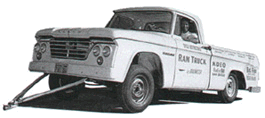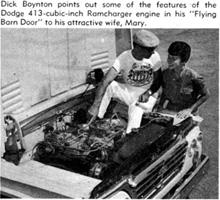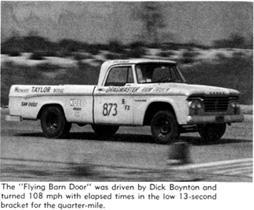Famous Sweptline Era Trucks
While there were many great Sweptline Era truck packages and models
available, there were even a few interesting trucks which were not available
on the showroom floor. Drag trucks, prototypes, and promotional vehicles
all played a role in the success of `61-`71 Dodge Trucks.
Hot... Dog?
 Did
you know that one of the original Oscar Meyer Weinermobiles was built on a
1967 Dodge Truck chassis? Custom Classic Trucks magazine featured a
short blurb about this amazingly popular vehicle in their February `98
issue. Click the small image at left for a reproduction of this article.
Did
you know that one of the original Oscar Meyer Weinermobiles was built on a
1967 Dodge Truck chassis? Custom Classic Trucks magazine featured a
short blurb about this amazingly popular vehicle in their February `98
issue. Click the small image at left for a reproduction of this article.
Dick Boynton's Flying Barn Door
 In 1963, Dick Boynton of San Diego talk radio fame began racing a Sweptline
Era Dodge Truck called the "Ram Truck". Also known as the "Flying Barn
Door," the truck was raced for a short while in the B/Factory Experimental
category at numerous race tracks around the country. In the engine bay,
Boynton had a 413 Max Wedge engine to power the massive truck. In one race,
Boynton beat a competitor running 12.71 at 108.99mph! Fiberglass front
fenders, hood, and front bumper were used to try and even out the 70/30
weight distribution. Too bad someone doesn't make parts like that today!
See below for more great information on this revolutionary drag truck.
In 1963, Dick Boynton of San Diego talk radio fame began racing a Sweptline
Era Dodge Truck called the "Ram Truck". Also known as the "Flying Barn
Door," the truck was raced for a short while in the B/Factory Experimental
category at numerous race tracks around the country. In the engine bay,
Boynton had a 413 Max Wedge engine to power the massive truck. In one race,
Boynton beat a competitor running 12.71 at 108.99mph! Fiberglass front
fenders, hood, and front bumper were used to try and even out the 70/30
weight distribution. Too bad someone doesn't make parts like that today!
See below for more great information on this revolutionary drag truck.
| Images from magazine or book
articles on the "Ram Truck" |
|---|
 | The
image at right is from the book, Mopar, The Performance Years
edited by Martyn Schorr. This particular article seems to show an early
version of the truck which still had the metal front end parts as well as
the longer wheelbase. It also mentions the same track time as the Hot
Rod blurb shown below. (File Size:
113K) (Special thanks to Steve Dreibelbis of Bernville, PA for
submitting this image) |
|---|
 | From Hot Rod
Magazine, January `98 issue. It looks as though the engine was
removed for transport purposes on this later version of the truck. You may
be able to tell that it also has the weight saving fiberglass front body
parts installed. (File Size: 34K) |
|---|
 | From
Power Wagon and Sport Utes Magazine, Summer `97 issue. In this
clipping, the Ram Truck is in action. Note the meaty rear tires and the
overall racing stance of the truck. Hmmm, ever wonder what it would be like
to drive one of these trucks at 115mph? (File Size:
42K) |
|---|
Images from the books or magazines mentioned
above.
Included below is an article titled, "The Flying Barn Door" by Lyle
Engel. It was found in The Dodge Book of Performance Cars.
Special thanks to Steve Dreibelbis for submitting this item.
THE FLYlNG BARN DOOR
Entertainment in the Stormin' Sixties applied, and applies, to the sport of
drag racing. Along with the other projects that were in process at the
Dragmaster Company in the early 1960s, was a desire to come up with an
unusual vehicle that would be an attention getter and also do a creditable
job of racing. At the time of this desire, the Los Angeles-Orange Counties
Dodge Dealers were reaping their publicity with the Dragmaster Dart, the
Golden Lancer, the "Maverick," and a host of other machines.
Directly to the south of the strange never-never land of Los Angeles was
another interested group of dealers, the San Diego Dodge Dealer Association.
Smaller than the L.A.-Orange Counties group, they totaled five, but had an
interest and a budget.
The desire plus the budget thus created one of the first of the true
exhibition drag race machines and it was an unusual combination. First the
driver, mechanic, and crew. By profession and appearance he was the most
unlikely to be picked by the astute television panel of What's My Line as
either a drag driver, mechanic, or even enthusiast. Dick Boynton, of San
Diego, was news director and a widely listened to disk jockey for radio
station KDEO. Articulate, well read, and, with no offense intended, somewhat
proper.
In addition, he was the "possessor" of a young, pretty, charming, and
immaculate-looking wife named Mary. Dick and Mary Boynton were driver,
mechanic, and crew.
Now for the vehicle. It was a Dodge D-100, Sweptline, 122-inch wheelbase,
pickup truck.
Ultimately this combination became "The Flying Bain Door" and for a very
good reason. Aerodynamically it had as much business on the drag strip as a
competition vehicle as the bumblebee has in formation flying with the
hawk.
Meanwhile, back at the old corral at Dragmaster, Boynton, despite his
professorial appearance and manner, had long been hooked on drag racing and
automotive competition. At age fifteen he had his first hot rod, a Model A
Ford roadster, Modfied with a Cragar overhead valve setup, he achieved a 98
mph mark on California's Muroc Dry Lake. This, prior to World War II,
provided the incentive. Service in the Navy as a motor machinist mate served
as an "education" period, and upon his return to civilian life he decided
that motorcycles were the only way to go.
A few times on his head and one bad accident changed his mind and he went
back to the four-wheel variety of racing. A succession of cars and trophies
brought him to the Dragmaster Company in 1962. Intrigued by a challenge, he
had successfully campaigned a Thunderbird on a drag strip when everyone knew
it couldn't run. And perhaps this was why a drag racing truck was chosen.
In collaboration with Jim Nelson the planning and preparation of the "Ram
Truck" began. The basic Dodge pickup was picked up from the San Diego Dodge
Dealers and stripped of engine and all running gear. By slide rule it was
figured that the truck would run in B/FX and if the resistance to the large
frontal area could be overcome it would stand a chance.
The 413-cubic-inch Ramcharger engine was installed. The heavy-duty
TorqueFlite automatic trans followed. Since the original truck was a
standard three-speed manual, the pushbuttons were placed in the slot
normally used for an ashtray. This to accommodate Boynton's preference for
right-hand shifting.
 Image from The Dodge Book of Performance
Cars.
Due to the ridiculous, weight distribution that resulted (on the 122-inch
wheelbase and a total weight of 3906 pounds, the end result was 70%
at the front and 30% to the rear) special 15-inch rear wheels were
made.
Image from The Dodge Book of Performance
Cars.
Due to the ridiculous, weight distribution that resulted (on the 122-inch
wheelbase and a total weight of 3906 pounds, the end result was 70%
at the front and 30% to the rear) special 15-inch rear wheels were
made.
In addition, a courageous fiberglass manufacturer was conned into making
a fiberglass hood, grille, bumper, and fenders for the truck. Despite the
simple lines of a D-100 truck, the set received was one of a kind and the
manufacturer vowed "never again." Nonetheless, the installation helped to
the point of making the weight distribution better if not entirely
practical.
The initial trial runs were more encouraging than anticipated. Numerous
problems were encountered; but taken one at a time, most were solved. The
light weight on the rear of the truck was most difficult. It was virtually
impossible to come off the line without breaking loose. The skillful
addition of lead in the tailgate and the tailgate down at the horizontal
position helped. Traction Master torque reaction arms added to the rear
contributed.
Tire pressures became important. The immense slicks worked best at 38
pounds. Front tires with 50 pounds of pressure. Contrary to most
automatice stockers, the maximum rpm of the line was 1200. Ideal was
1100.
Practice of driving techniques improved and the "Door" did better. With
this accomplished, Boynton started to go for speed and e.t.
A new problem developed. After the truck hit a speed of 110 mph, new
squirreliness occurred on deceleration. Feeling that perhaps the
aerodynamics were a problem, the front end was altered slightly to permit
more air to go through and two vents were cut in the bottom of the box to
allow the air stream to escape over the cab and down.
Whether these moves were fact or fancy, no one cared, as they seemed to
work.
 Image from The Dodge Book of Performance
Cars.
Image from The Dodge Book of Performance
Cars.
The initial competitive appearance of the Ram truck came off with double
takes and stares. Few, if any, at the track had ever seen a stock car
towing a truck.
Time trials looked great. The acoustics of a truck were far different from a
stocker. The Horsepower Engineering headers were tuned to sound like
Westminister Abbey's pipe organ, and dinner glassware was shattered within
the town of La Verne close to Pomona's drag strip.
In competition, the Ram truck met first a respectible B/FX Chevy. Off the
line, Boynton was poetry in motion. The truck left first; and for the first
fifty feet there were two car lengths, or rather two truck lengths, of
daylight between. It was the Ram truck all the way to the three-quarter
mark. . . and then theaerodynamics set in. The "Barn Door" started its
resistance. Boynton won, but by the length of his fiberglass bumper. And so
it went weekend after weekend. He didn't win them all, but every race was a
good one, as the truck was always first out and then seemed to poop out like
an out-of-condition sprinter near the finish line.
Boynton, truck, and crew went to the Nationals in Indianapolis. They
didn't win, but the underdog truck was a crowd favorite.
After a year and a half the old D-100 was retired from the
Southern California tracks. Like an old soldier, it didn't die; it went to
Texas and played the smaller tracks. Its whereabouts now are unknown. It may
be hauling hay, but it still puts on a good show, we're sure.
Reference:
Engel, Lyle Kenyon. The Dodge Book of Performance Cars. New York:
Pocket Books, 1967.
| Pre-History | A-100's | '61-Mid '65
Trucks | '65-67 Trucks | '68-'71 Trucks |
| CSS\Adventurer Trucks | Sweptline
Power Wagons | Medium/Heavy Duty Trucks
|
| Main Page | Online Response |
Part Sources |
Sweptline.org Forums |


 Did
you know that one of the original Oscar Meyer Weinermobiles was built on a
1967 Dodge Truck chassis? Custom Classic Trucks magazine featured a
short blurb about this amazingly popular vehicle in their February `98
issue. Click the small image at left for a reproduction of this article.
Did
you know that one of the original Oscar Meyer Weinermobiles was built on a
1967 Dodge Truck chassis? Custom Classic Trucks magazine featured a
short blurb about this amazingly popular vehicle in their February `98
issue. Click the small image at left for a reproduction of this article.




